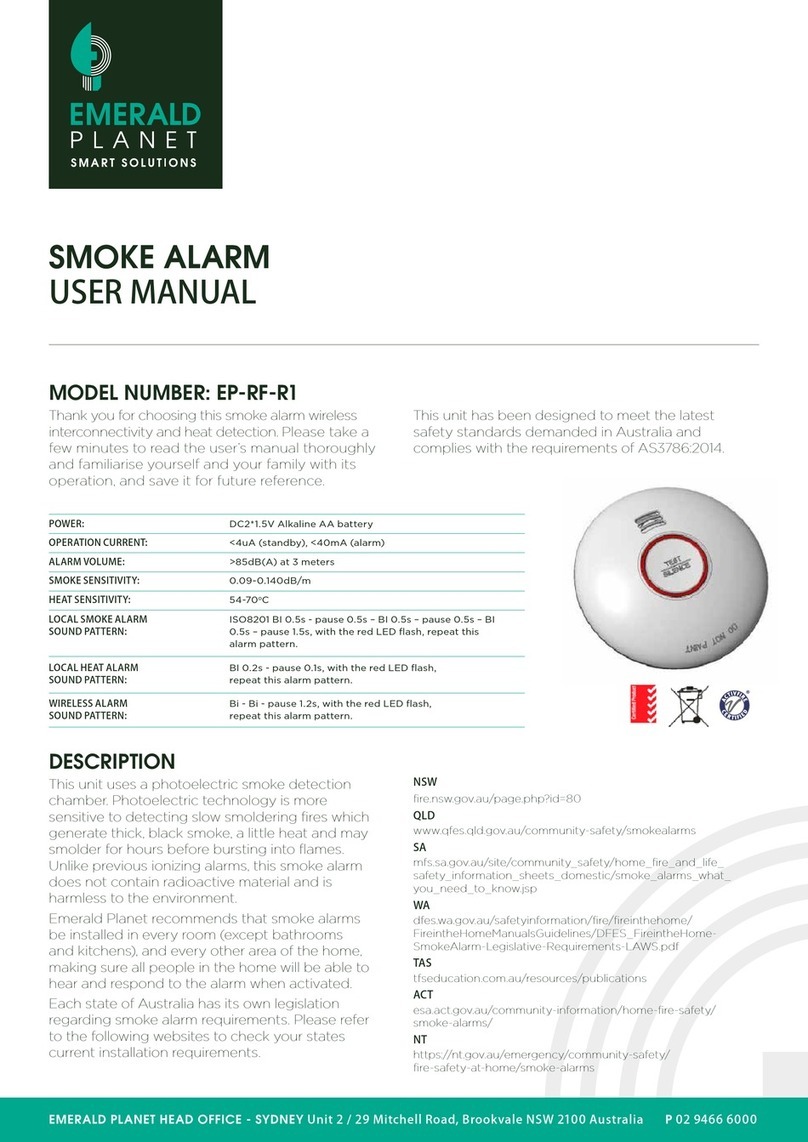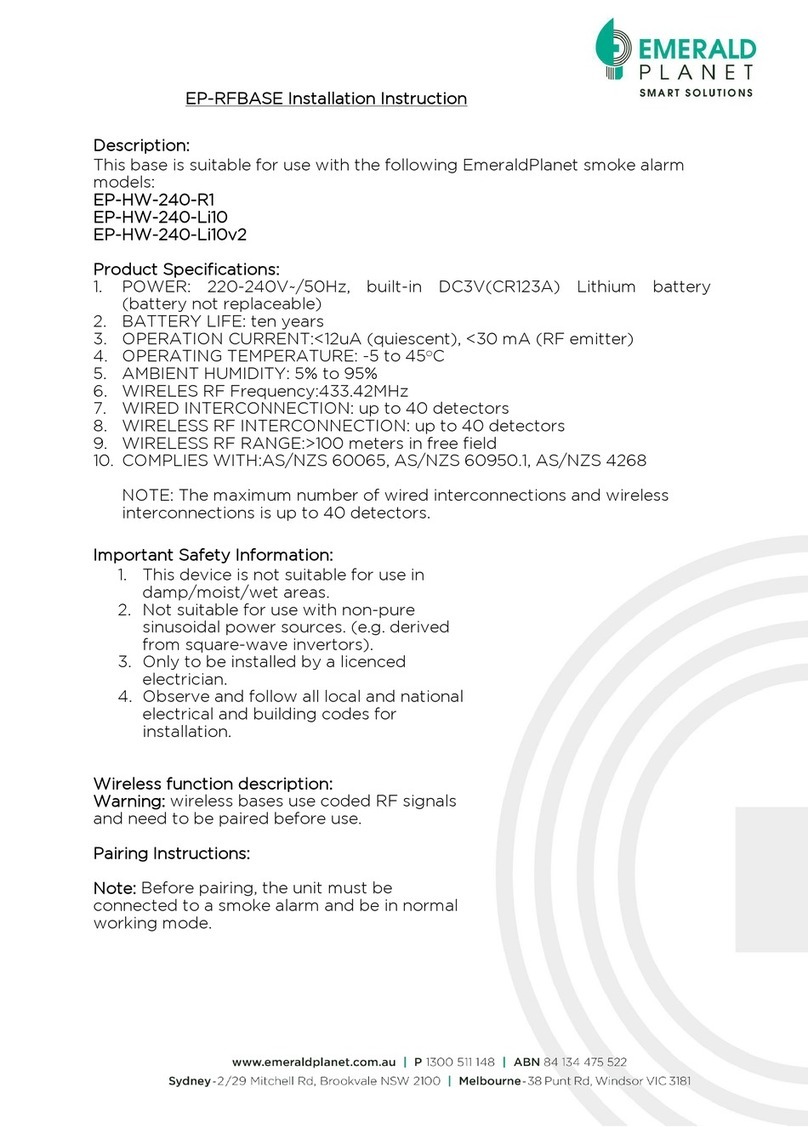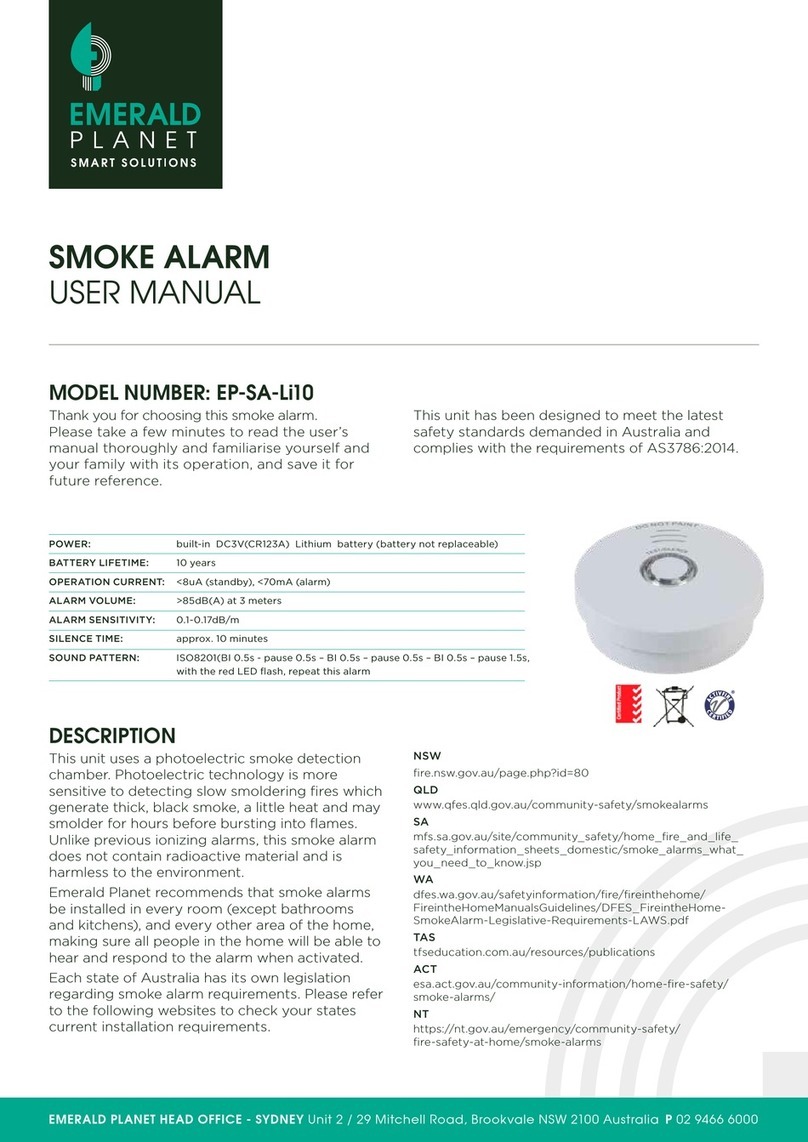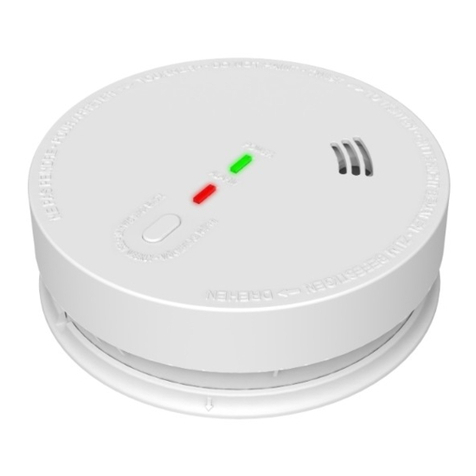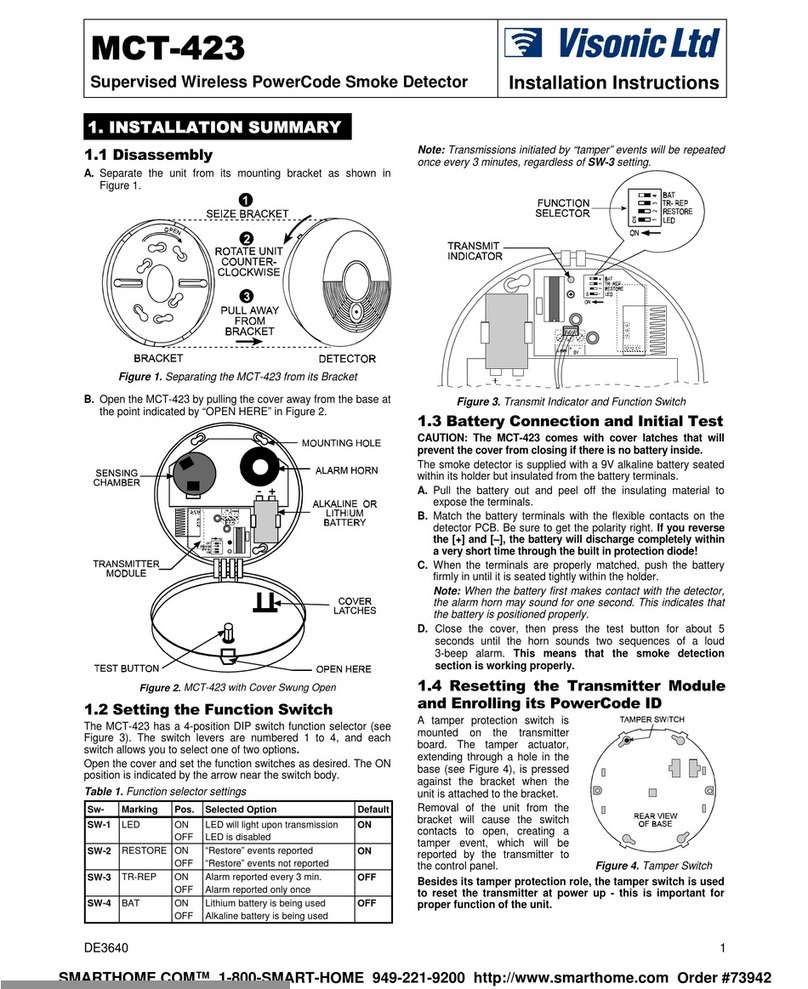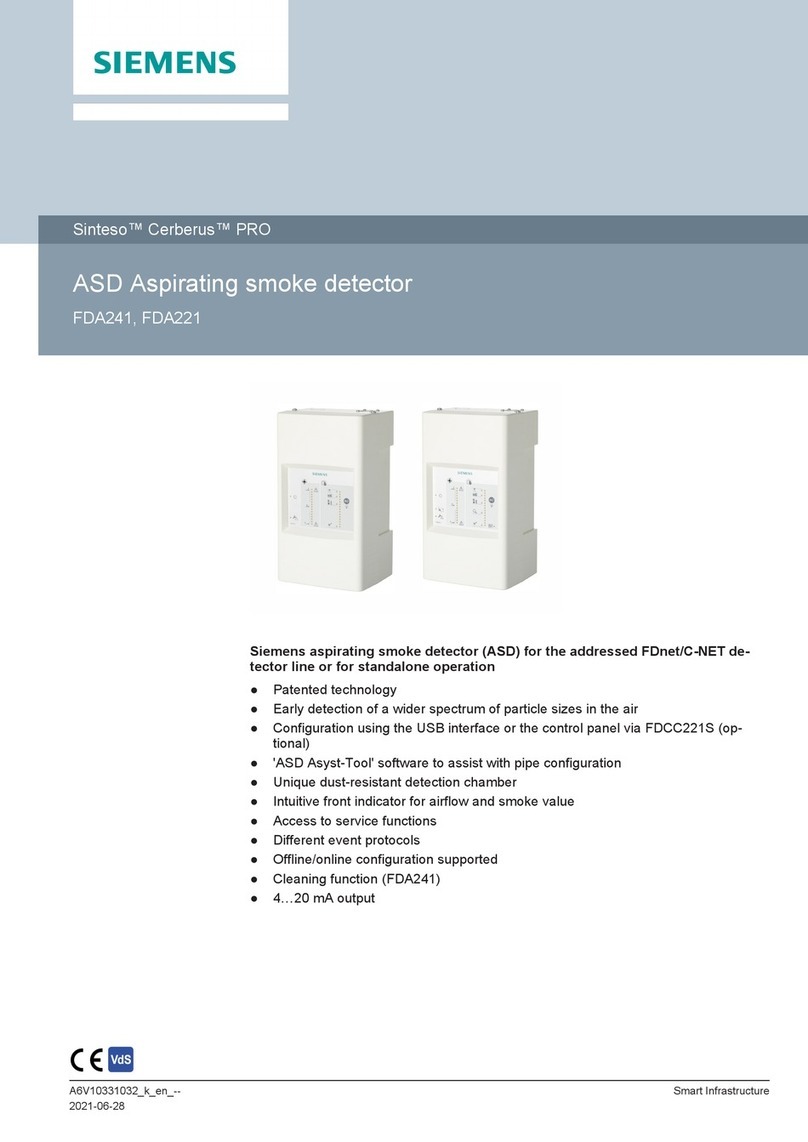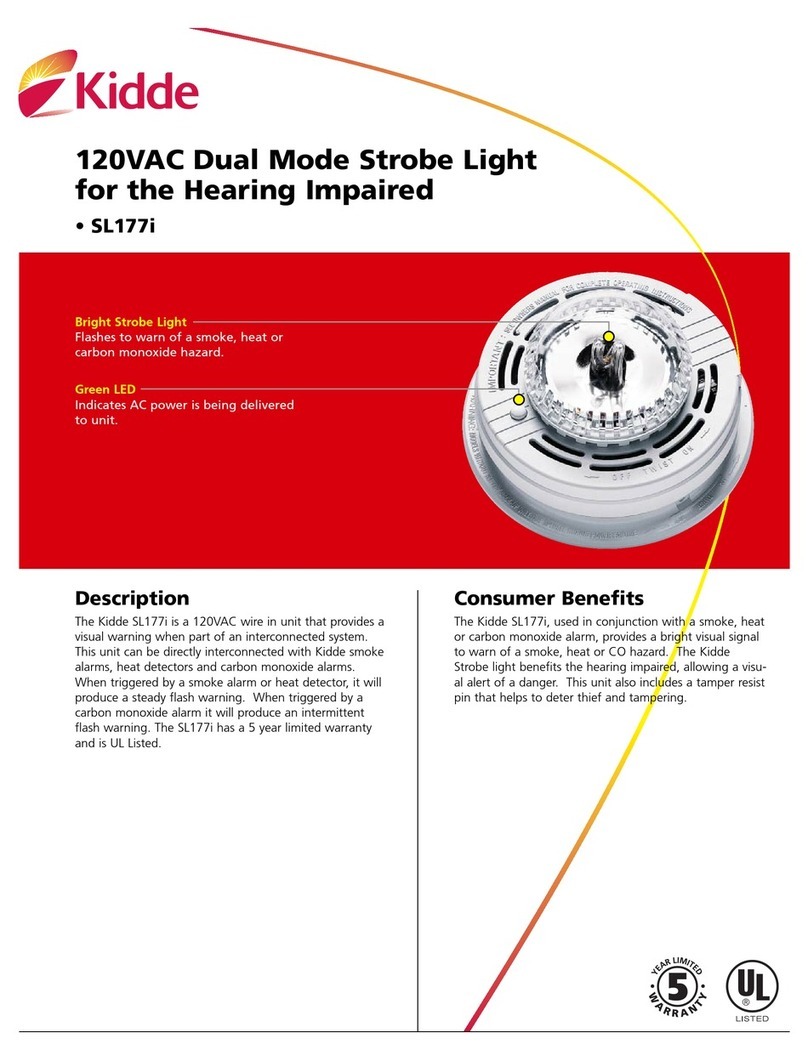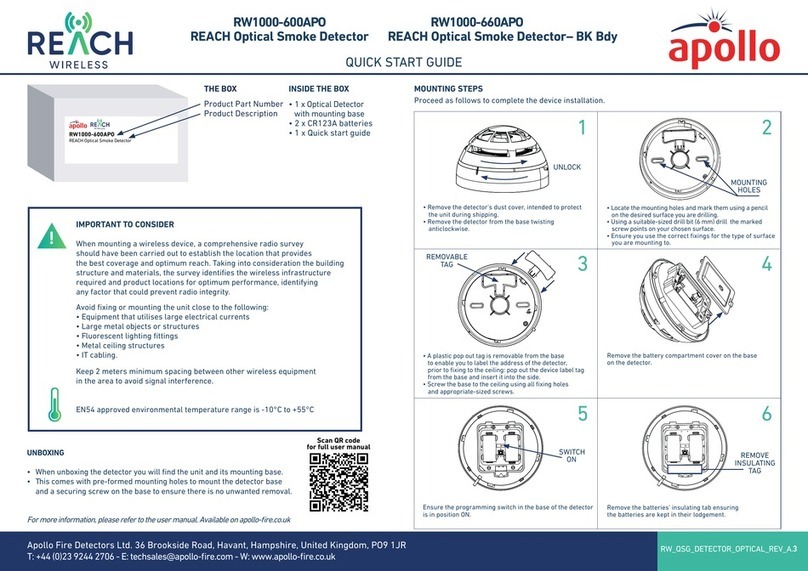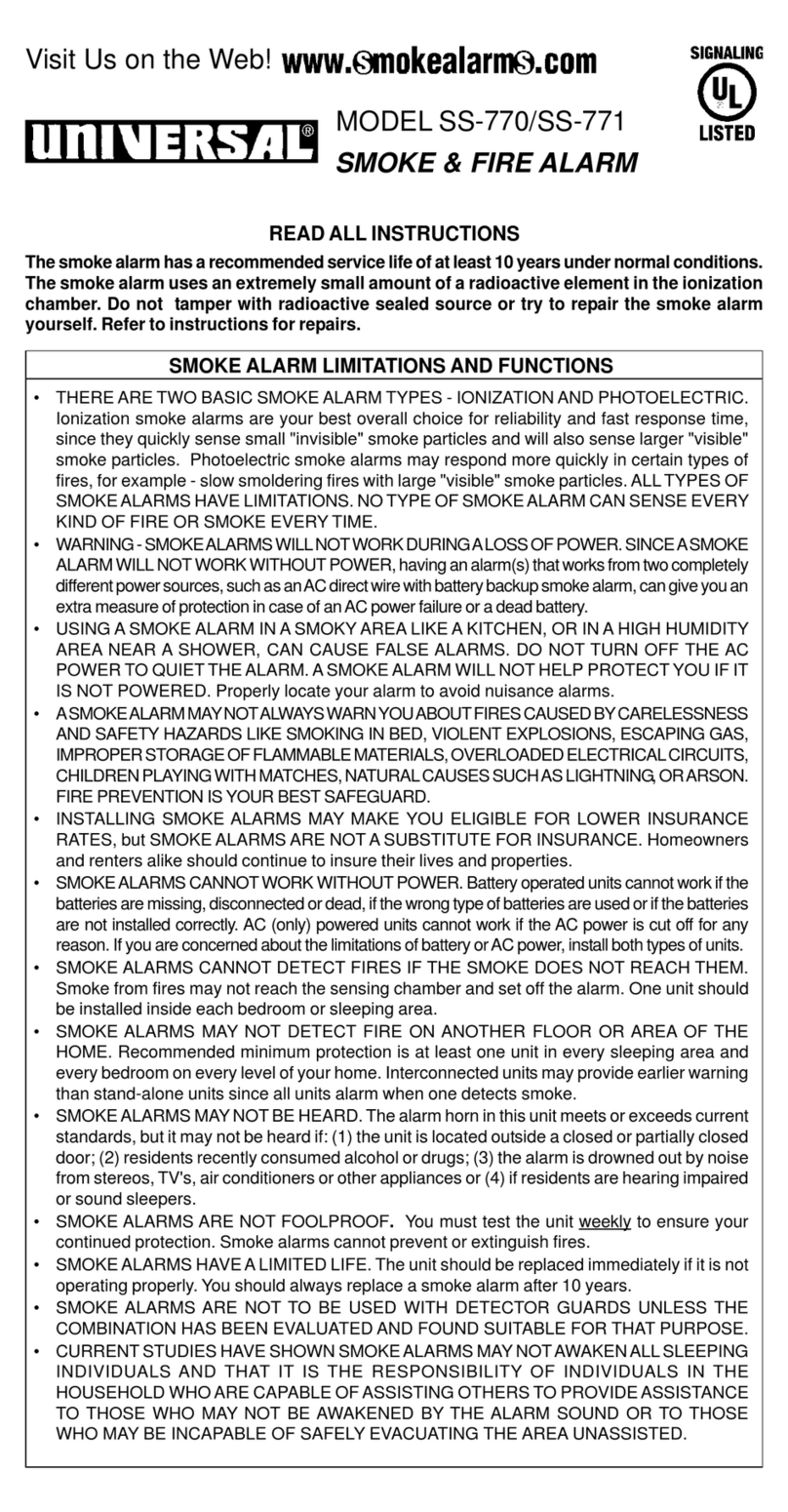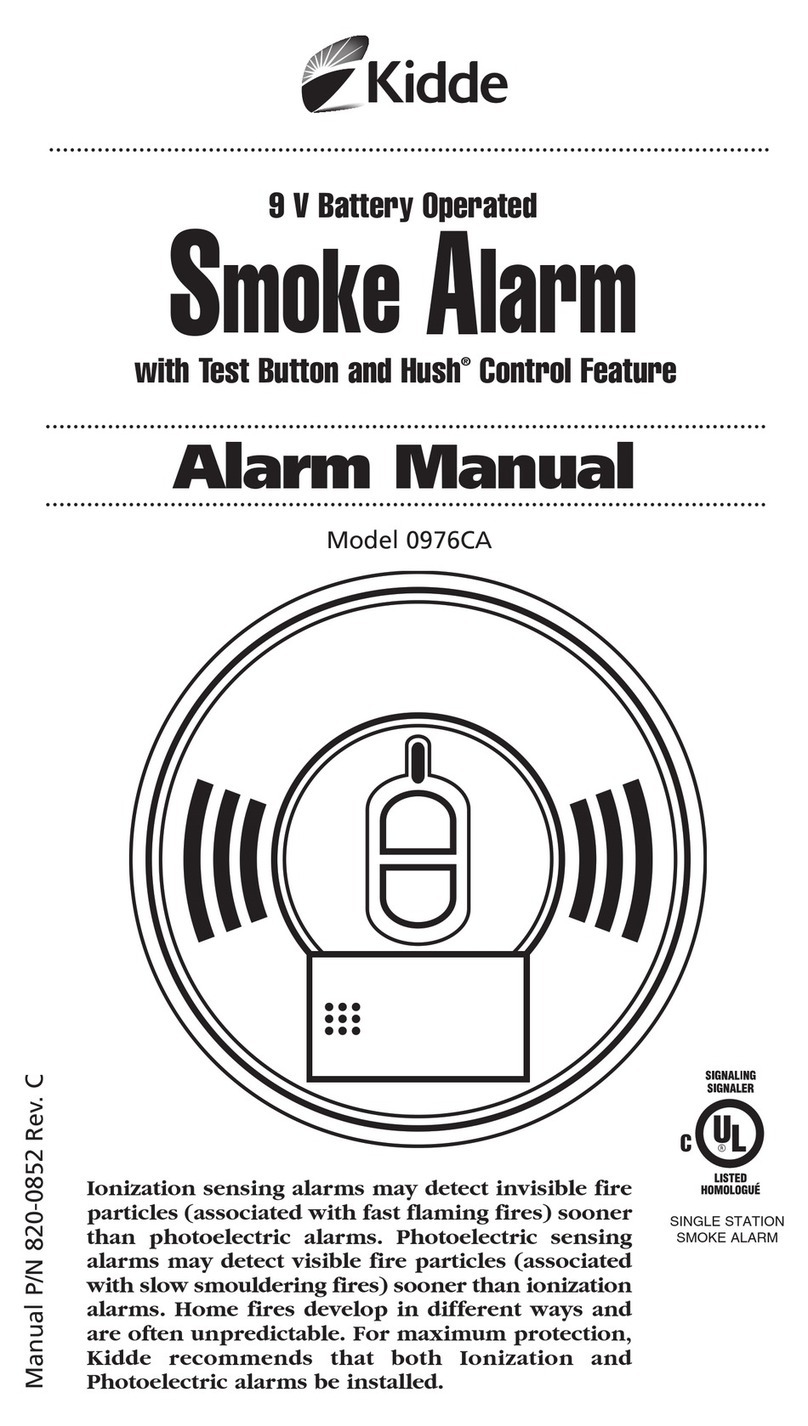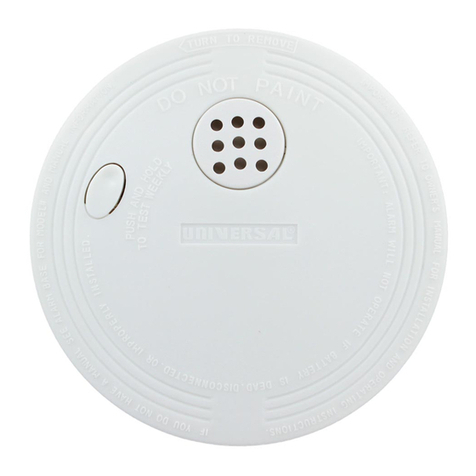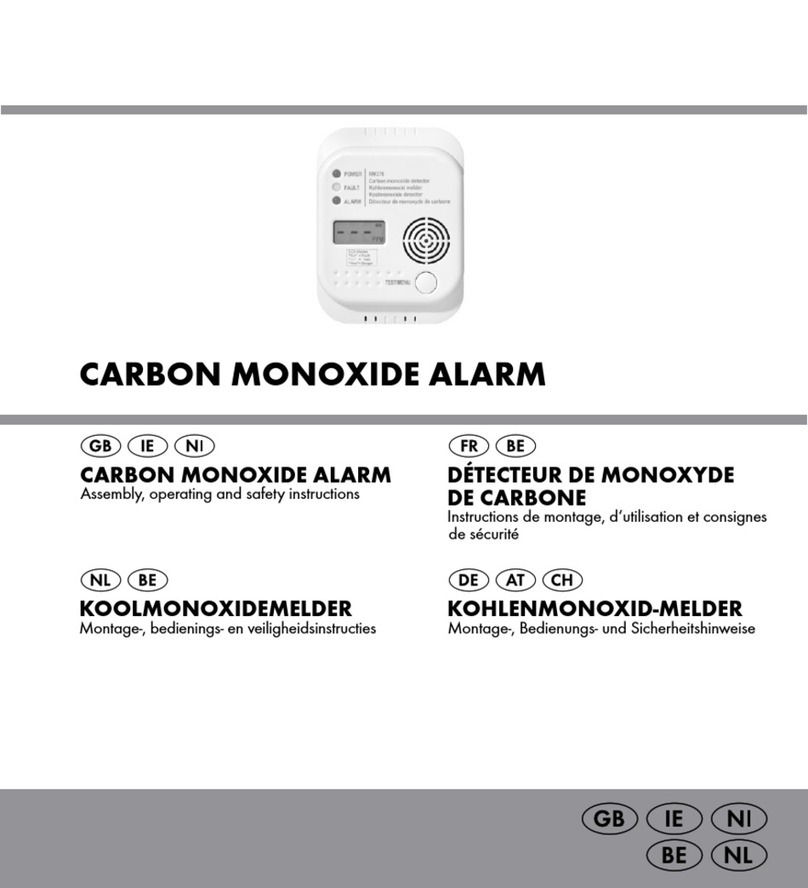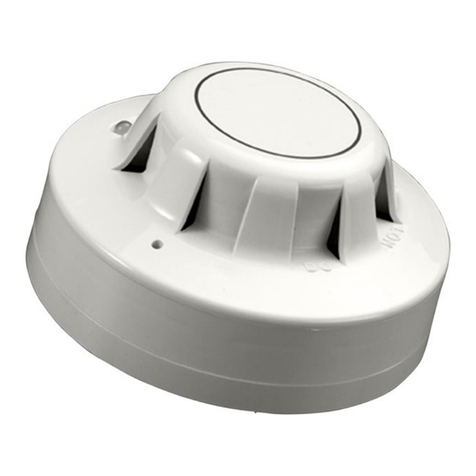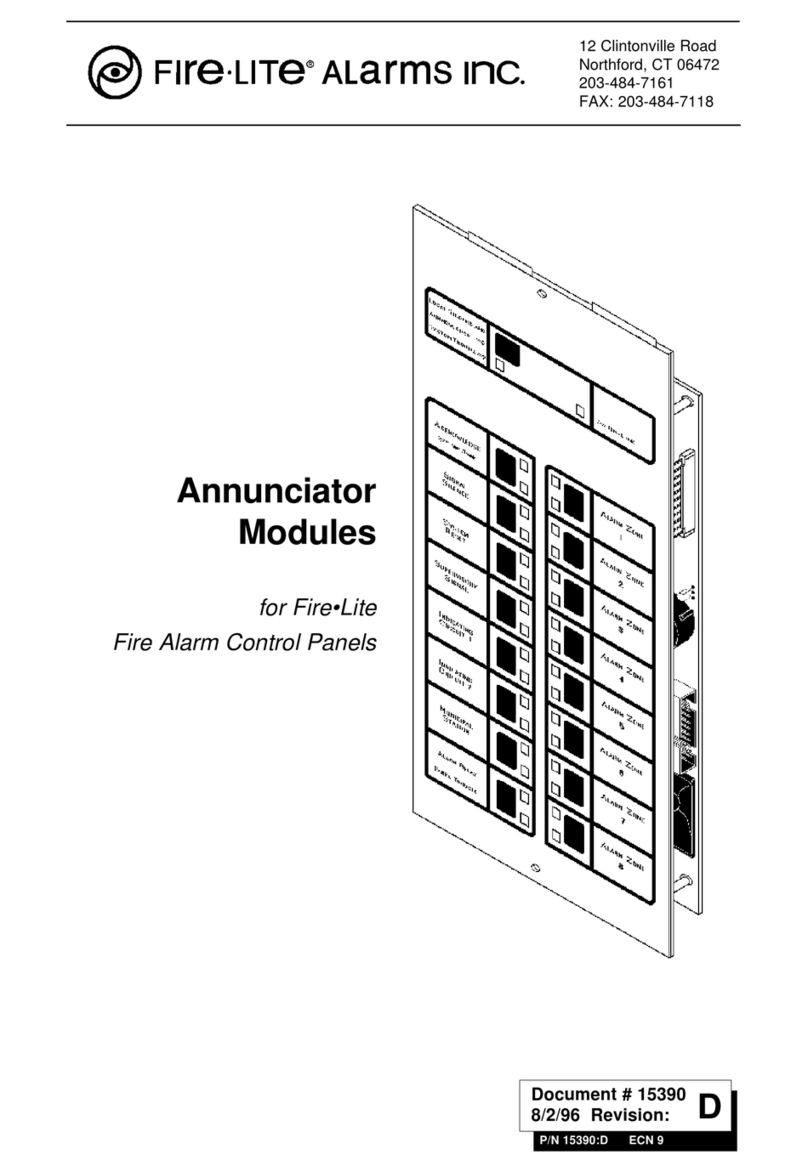Emerald Planet EP-RF-Li10 User manual

EMERALD PLANET HEAD OFFICE - SYDNEY Unit 2 / 29 Mitchell Road, Brookvale NSW 2100 Australia P02 9466 6000
SMOKE ALARM
USER MANUAL
DESCRIPTION
This unit uses a photoelectric smoke detection
chamber. Photoelectric technology is more
sensitive to detecting slow smoldering fires which
generate thick, black smoke, a little heat and may
smolder for hours before bursting into flames.
Unlike previous ionizing alarms, this smoke alarm
does not contain radioactive material and is
harmless to the environment.
Emerald Planet recommends that smoke alarms
be installed in every room (except bathrooms
and kitchens), and every other area of the home,
making sure all people in the home will be able to
hear and respond to the alarm when activated.
Each state of Australia has its own legislation
regarding smoke alarm requirements. Please refer
to the following websites to check your states
current installation requirements.
NSW
fire.nsw.gov.au/page.php?id=80
QLD
www.qfes.qld.gov.au/community-safety/smokealarms
SA
mfs.sa.gov.au/site/community_safety/home_fire_and_life_
safety_information_sheets_domestic/smoke_alarms_what_
you_need_to_know.jsp
WA
dfes.wa.gov.au/safetyinformation/fire/fireinthehome/
FireintheHomeManualsGuidelines/DFES_FireintheHome-
SmokeAlarm-Legislative-Requirements-LAWS.pdf
TAS
tfseducation.com.au/resources/publications
ACT
esa.act.gov.au/community-information/home-fire-safety/
smoke-alarms/
NT
https://nt.gov.au/emergency/community-safety/
fire-safety-at-home/smoke-alarms
MODEL NUMBER: EP-RF-Li10
Thank you for choosing this smoke alarm with
wireless interconnectivity. Please take a few
minutes to read the user’s manual thoroughly
and familiarise yourself and your family with its
operation, and save it for future reference.
This unit has been designed to meet the latest
safety standards demanded in Australia and
complies with the requirements of AS3786:2014.
POWER: Built-in DC 3V 10yr rated Lithium ion battery (battery not replaceable)
OPERATION CURRENT: <70mA
ALARM VOLUME: >85dB(A) at 3 meters
SMOKE SENSITIVITY: 0.09-0.15dB/m
LOCAL SMOKE ALARM ISO8201 Bi 0.5s - pause 0.5s – Bi 0.5s – pause 0.5s – Bi 0.5s –
SOUND PATTERN: pause 1.5s, with a red LED flash, this pattern repeats.
WIRELESS ALARM Bi-Bi-pause 1s,repeat this alarm pattern
SOUND PATTERN:

EMERALD PLANET HEAD OFFICE - SYDNEY Unit 2 / 29 Mitchell Road, Brookvale NSW 2100 Australia P02 9466 6000
IMPORTANT SAFETY INFORMATION
1: The test button accurately tests the smoke alarm functions. Do not
use any other test method. Test smoke alarms weekly to ensure
proper operation.
2: If you’re sure it isn’t a real alarm, open windows or fan the air
around the smoke alarm device to silence it.
3: Observe and follow all local and national electrical and building
codes for proper installation.
4: This smoke alarm is designed to be used in residential premises
only. Do not install in non-residential buildings. This smoke alarm is
not a substitute for a complete alarm system.
5: Install a smoke alarm in every room and on every level of the home.
Smoke may not reach the smoke alarm for many reasons. For
example, if a fire starts in a remote part of the home, on another
level, in a chimney, wall, roof, or on the other side of a closed door,
smoke may not reach the smoke alarm in time to alert household
members. A smoke alarm will not promptly detect a fire except in
the area or room in which it is installed.
6: Smoke alarms may not alert every household member every
time. The alarm sound is loud in order to alert individuals to a
potential danger. However, there may be some circumstances
where a household member may not hear the alarm (i.e. outdoor
or indoor noise, deep sleepers, drug or alcohol usage, the hard of
hearing, etc.). If you suspect that this smoke alarm may not alert a
household member, install and maintain specialty smoke alarms.
Every household member must hear the alarms warning sound
and quickly respond to it to reduce the risk of injury, or death that
may result from fire.
7: Smoke alarms can only activate when they detect smoke or detect
combustion particles in the air. They do not sense heat, flames,
or gas. This smoke alarm is designed to give audible warning of a
developing fire. However, many fires are fast - burning, explosive,
or intentional, and others are caused by carelessness or safety
hazards. In these circumstances, there may be insufficient smoke
to activate the alarm QUICKLY ENOUGH to ensure safe escape.
8: Smoke alarms have limitations. This smoke alarm is not foolproof
and is not warranted to protect lives or property from fire. Smoke
alarms are not a substitute for insurance. Homeowners and renters
should insure their lives and property. In addition, it is possible for
the smoke alarm to fail at any time. For this reason, you must test
the smoke alarm weekly and replace unit every 10 years.
DO NOT INSTALL SMOKE ALARMS IN THE
FOLLOWING PLACES
1: Near appliances or areas where normal combustion regularly
occurs (kitchens, near furnaces, open fireplaces, hot water
heaters etc.).
2: In areas with high humidity, like bathrooms or areas near
dishwashers or washing machines. Install at least 10 feet
away from these areas.
3: Near air returns or heating and cooling supply vents. Install
at least 3 feet away from these areas. The air could blow
smoke away from the detector, interrupting its alarm.
4: In rooms where temperatures may fall below 5° or rise above
45°, or in humidity higher than 85%. These conditions could
reduce battery life or cause a false alarm.
5: In extremely dusty, dirty, or insect–infested areas influence
particles interfere with smoke alarm device operation.
OPERATION
ACTIVATION
To activate the smoke alarm, align the mounting plate and
turn it clockwise until it snaps into place. The battery is now
connected and the smoke alarm is active.
TESTING
Test the unit to ensure proper operation by pressing the test button,
this will sound the alarm if the electronic circuitry, horn, and battery
are working. If no alarm sounds, please refer to the “Troubleshooting”
section for solution.
DO NOT USE AN OPEN FLAME TO TEST YOUR ALARM, YOU
COULD DAMAGE THE ALARM OR IGNITE COMBUSTIBLE
MATERIALS AND START A FIRE.
CAUTION: DUE TO THE LOUDNESS (85 DECIBELS) OF THE
ALARM, ALWAYS STAND AT ARMS-LENGTH AWAY FROM
THE UNIT WHEN TESTING. TEST THE ALARM WEEKLY TO
ENSURE PROPER OPERATION. ERRATIC OR LOW SOUND
COMING FROM YOUR ALARM MAY INDICATE A DEFECTIVE
ALARM, PLEASE REFER TO “TROUBLESHOOTING” SECTION
FOR SOLUTION.
NOTE: WEEKLY TESTING IS REQUIRED.
LED INDICATORS
Red LED-Flashing once every 40 seconds: indicates that the
smoke alarm device is operating properly.
Red LED-Flashing when the test button is pressed, or when the
smoke alarm device senses particles of combustion and goes
into alarm (constant pulsating sound), the red LED will flash
once per second. The flashing LED and pulsating alarm will
continue until the air is cleared or test button is released.
Red LED-Alarm silencer (Hush mode) indication: The red LED
will flash once every 8 seconds, indicating the smoke alarm
device is in the alarm silence (Hush) mode.
Low battery indication - An intermittent “chirp” with red
LED flashes once every 40 seconds: indicates that the smoke
alarm device is low on battery, you may press the test button
to pause the alarm for 10 hours, but it will reset automatically
after 10 hours.
Fault indication - The alarm chirp occurs every 40 seconds.
NOTE: WHEN THE UNIT CHIRPS ONCE EVERY 40 SECONDS,
YOU CAN PRESS THE TEST BUTTON TO TEMPORARILY
PAUSE THIS WARNING TONE FOR 10 HOURS. IT CAN STILL
NORMALLY DETECT SMOKE DURING THIS PERIOD, IT ONLY
REMOVES NUISANCE WARNING TONE. YOU CAN REFER TO
“TROUBLESHOOTING” FOR SOLUTION. IF THERE ARE STILL
FAILURES, YOU MUST REPLACE IT WITH A NEW ALARM AT
ONCE OR CONTACT YOUR RETAILER DURING WARRANTY
PERIOD.
ALARM SILENCE (HUSH MODE)
To silence an alarm, push the test button, it will pause the
alarm for approx. 10 minutes. The red LED will flash once every
8 seconds, it indicates the smoke alarm is running in “silence
mode”. Smoke alarms are designed to minimise nuisance
alarms. Combustion particles from cooking may set off the
alarm if the alarm is located close to the cooking area.
Large quantities of combustible particles are generated from
spills or when grilling/frying. Using the fan on a range hood
that vents to outside (non-recirculating type) will also help
remove these combustible particles from the kitchen. The
alarm silence (test button) is extremely useful in a kitchen area
or other areas prone to nuisance alarms. The silence feature is
to be used only when a known alarm condition, such as smoke
from cooking activates the alarm.
The smoke alarm will automatically reset after approximately
10 minutes, if after this period, particles of combustion are still
present, the alarm will sound again. The alarm silencer (silence
mode) can be repeatedly until the air has been cleared of the
condition causing the alarm.
CAUTION: BEFORE SILENCING THE ALARM IDENTIFY THE
SOURCE OF SMOKE AND ENSURE THERE IS NO RISK OF
FIRE.
NOTE: DENSE SMOKE WILL OVERRIDE THE SILENCE MODE
AND THE ALARM WILL SOUND A CONTINUOUS ALARM
AGAIN.
DANGER: IF THE ALARM SOUNDS, AND IT IS NOT BEING
TESTED, IT MEANS THE UNIT IS DETECTING SMOKE AND
REQUIRES YOUR IMMEDIATE ATTENTION AND ACTION.

EMERALD PL ANET HEAD OFFICE - SYDNEY Unit 2 / 29 Mitchell Road, Brookvale NSW 2100 Australia P02 9466 6000
MAINTENANCE & CLEANING
The alarm should be cleaned at least once a year.
•To clean your alarm, remove it from its bracket on ceiling,
you can clean it by using compressed air or a vacuum
cleaner hose with a soft brush attachment. Blow or vacuum
around the perimeter of the alarm to remove dust and dirt
and debris. The outside of the alarm can be wiped with a
damp cloth but you should avoid using a wet cloth in order
to avoid water entering the interior of alarm.
•After cleaning, reinstall it and test it by pressing the Test
button. The alarm should be replaced if cleaning can’t
restore the alarm to normal operation.
•This alarm has a low battery monitor which will cause the
alarm to “chirp” approx. every 40 seconds and the red LED
flash once at the same time for a minimum of thirty days
when the battery gets low.
If there is a defective battery or other failures, you can refer
to “Troubleshooting” for solution, or deactivate this alarm
to stop nuisance alarm which is caused by a failure of their
function. If there are still failures during warranty period, you
can return to your retailer.
•Don’t paint the unit. Paint will seal the vents and interfere
with the sensor’s ability to detect smoke.
NOTE:
1. REGULAR WEEKLY TESTING IS RECOMMENDED.
2. ALARMS MUST BE REACTIVATED BEFORE USE IF
THEY ARE DEACTIVATED.
REPLACING THE ALARM
It is recommended this alarm should be replaced ten years
from the date of manufacture. This date has been provided on
the product label which is located on the back of the alarm.
WARNING: THE BATTERY IS SEALED INSIDE THE UNIT AND
IS NOT REPLACEABLE. PLEASE REPLACE THE ALARM IF
THE LOW BATTERY CHIRP SIGNAL OCCURS.
IMPORTANT: DO NOT ATTEMPT TO REMOVE THE COVER
TO CLEAN INSIDE. THIS WILL AFFECT WARRANTY.
REPAIR
If the alarm is not operating properly, and is still under
warranty, return it to the original place of purchase.
If the alarm is no longer under warranty, please replace it
immediately with a comparable alarm.
CAUTION: DO NOT ATTEMPT TO REPAIR THE ALARM. IT
WILL AFFECT YOUR WARRANTY.
PRACTICE FIRE SAFETY
If the alarm sounds, and the test button has not been pressed,
it is warning of a potentially dangerous situation. To prepare for
such occurrences, develop family escape plans, discuss them
with all household members, and practice them regularly.
1: Familiarise everyone with the sound of a smoke alarm and
explain what the sound means.
2: Determine possible exits from each room and an escape
route to the outside from each exit.
3: Educate all household members to touch the door and use
an alternate exit when the door is hot, instruct them not to
open the door if the door is hot.
4: Teach household members to crawl along the floor to stay
below dangerous smoke, fumes and gases.
5: Determine a safe meeting place for all members outside the
building.
WHAT TO DO IN CASE OF FIRE
1: Do not panic, stay calm.
2: Leave the building as quickly as possible. Touch doors to
feel if they are hot before opening them. Use an alternate
exit if necessary. Crawl along the floor, and do stop to
collect anything.
3: Meet at a pre-arranged meeting place outside the building.
4: Call the fire department from outside the building.
5: Do not go back inside a burning building. Wait for the fire
department to arrive.
NOTE: THESE GUIDELINES WILL ASSIST YOU IN THE EVENT
OF A FIRE, ALWAYS FOLLOW THE INSTRUCTIONS OF
FIREFIGHTING PROFESSIONALS.
WARRANTY INFORMATION
Emerald Planet warrants this smoke alarm to the original
purchaser.
Emerald Planet warrants each new smoke alarm is free from
defects in material and workmanship under normal use and
service for a period of 5 years from the date of purchase.
This warranty does not cover damage resulting from accident,
misuse or abuse or lack of reasonable care of the product.
In no case shall Emerald Planet be liable for any incidental
or consequential damages for breach of this or any other
warranty express or implied whatsoever. Faulty product can be
mailed to the following address with a detailed explanation of
problem.
Emerald Planet
2/29 Mitchell Road,
Brookvale NSW 2100

EMERALD PL ANET HEAD OFFICE - SYDNEY Unit 2 / 29 Mitchell Road, Brookvale NSW 2100 Australia P02 9466 6000
INSTALLATION POSITIONING ADVICE
When mounting an alarm on the ceiling, locate it a minimum
of 30 cm from the side wall (see Diagram 5).
•Put smoke alarms at both ends of a bedroom hallway or
large room if larger than 10m long.
•Install smoke alarms on slopped, peaked or cathedral
ceilings between 500 and 1500mm from the highest point
of the ceiling. Smoke alarms in rooms with ceiling slopes
greater than 1m in 8 m horizontally should be located on
the high side of the room (See Diagram 6).
DIAGRAM 6
PEAK CEILING PLACEMENT
DIAGRAM 4
MULTIPLE FLOOR PLAN
DIAGRAM 5
CEILING PLACEMENT
Smoke alarm should be located
between 500mm and 1500mm
from the highest point.
SLOPED CEILING PLACEMENT
WIRELESS PAIRING
WIRELESS FREQUENCY: 433MHz
OPERATION CURRENT: RF Receiver: <6mA
RF emitter: <30mA
MAXIMUM NUMBER OF 30PCS
INTERCONNECT PRODUCTS
WIRELESS DISTANCE > 20 meters
Note: Make sure the batteries are
installed correctly before
operating the product.
1. 1: Set the first smoke alarm to “Pair Mode”
Note: Before operation, the unit must be in normal
working mode. It is advisable to pair all alarms prior to
installation.
a. Press the test/hush button 3 times within 2 seconds, a red
NET LED will light for a few seconds within the alarm (if
not previously networked) or a green NET LED will light
for a few seconds within the alarm (If already networked),
then a blue NET LED is lit for 30 seconds, the smoke
alarm is now ready to pair with the next alarm.
2. Set next smoke alarm to “Learning Mode”
a. While the first smoke alarm is in “Pair Mode” with a blue
NET LED light showing (pair within 30 seconds) Press
the test/hush button on the second smoke alarm 3 times
within 2 seconds, both green NET LED will light for 3
seconds indicating the radio link is successfully paired
Note: Products can be paired repeatedly, but all
products must be paired with the same primary smoke
alarm. Please remember this product.
3. To cancel pairing
If you want to cancel network pairing:
a. Ensure the power is be disconnected by turning the
mounting plate anti-clockwise until it unlocks.
b. Press the test/hush button and hold down (do not release),
and at the same time reconnect power by twisting the
mounting plate clockwise until it locks into place.
c. The red LED will light for 3 seconds, then release the test
button when the red LED light switches off.
d. When the button is released, the red LED will light for 3
seconds. In these 3 seconds, press the button to clear all
paired alarms, the red LED will flash for a while. When the
red LED stops flashing, the network is successfully cleared.
4. Radio link test
To ensure that all the products have been successfully paired;
a. Select one device, press and hold the button for about 2
seconds until the smoke alarm enters “Test alarm mode”
and then release the button, the device will automatically
send “Radio link test” information.
b. After short delay, all other paired alarms will enter “Radio
link test” status (red LED flash twice every second for 5
minutes, beep twice every second for 10 seconds). If
an alarm does not start flashing red, then network pairing
has failed or the distance between the connected alarms is
too great (the connected devices cannot reach each other).
Note: In “Radio link test” status device, press the
button and the device immediately enter the normal
standby mode.
Note: Before installing, place the product in each
installed room and select the device in the farthest room
for this test, to ensure that other products successfully
enter the “Radio link test” status.

EMERALD PL ANET HEAD OFFICE - SYDNEY Unit 2 / 29 Mitchell Road, Brookvale NSW 2100 Australia P02 9466 6000
INSTALLATION
•Turn the alarm body anticlockwise and remove the
mounting bracket.
•Position the bracket into the desired position, mark
installation holes of the bracket with pencil.
•Bore two 5mm installation holes with an electric drill. Insert
the two plastic plugs into the holes with a hammer.
•Attach the bracket to the plastic plugs by driving the
screws into the plastic plugs (See Diagram 7).
•Fit the alarm on the bracket and turn the alarm body
clockwise, until you feel a click.
•Press and hold the button to test the unit. The alarm will
sound once indicating a successful test. If there is no
sound, it may indicate a defective alarm or flat battery, you
can refer to “Troubleshooting” for solution or return to your
retailer during warranty period.
•When testing an interconnected smoke alarm all paired
alarms should also sound for 1 minute. This will also test if all
smoke alarms are successfully wirelessly interconnected. If
an alarm does not sound, re-pair it with the primary alarm.
•If you have any questions on installation, please contact
your retailer.
•If you have any questions on installation, you can contact
your retailer.
WARNING: TO PREVENT THE RISK OF INJURY, THIS
UNIT MUST BE SECURELY FASTENED TO THE WALL OR
CEILING IN ACCORDANCE WITH THESE INSTALLATION
INSTRUCTIONS.
DIAGRAM 7
PROBLEM TROUBLE SHOOTING
Alarm does not sound during testing 1. Fit the alarm on the bracketand turn the alarm body clockwise
for POWER ON.
2. Clean smoke alarm. Refer to “Maintenance & Cleaning” section.
3. Contact supplier for advice
The alarm “chirps” and red LED flashes
every 40 seconds
1. The battery is low. Replace the battery.
Refer to “Battery Replacement” section above
The alarm “chirps” every 40 seconds.
(no led Flash)
1. Clean smoke alarm. Refer to “Maintenance & Cleaning” section.
2. Replace smoke alarm if problem persists.
Smoke Alarm sounds unnecessarily. (e.g.
for no apparent reason, while cooking,
when someone is showering etc.)
1. Press the “Test” button to pause the alarm.
2. Clean smoke alarm. Refer to “Maintenance & Cleaning” section.
3. Move smoke alarm to new location if necessary and press the “Test” button.
Interconnected smoke alarm does not
sound when others do.
1. Re-pair smoke alarm with primary alarm.
2. Move smoke alarm closer to nearest smoke alarm.
TROUBLESHOOTING
p
p
p
pl
l
l
la
a
a
as
s
s
st
t
t
ti
i
i
ic
c
c
cp
p
p
pl
l
l
lu
u
u
ug
g
g
gs
s
s
s
t
t
t
tw
w
w
wo
o
o
os
s
s
sc
c
c
cr
r
r
re
e
e
ew
w
w
ws
s
s
s
h
h
h
ho
o
o
ol
l
l
le
e
e
es
s
s
so
o
o
of
f
f
fw
w
w
wa
a
a
al
l
l
ll
l
l
l
Table of contents
Other Emerald Planet Smoke Alarm manuals
